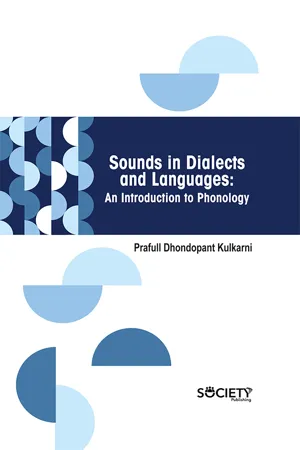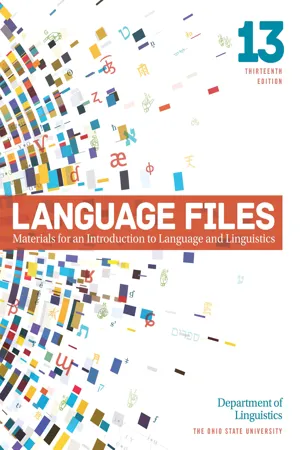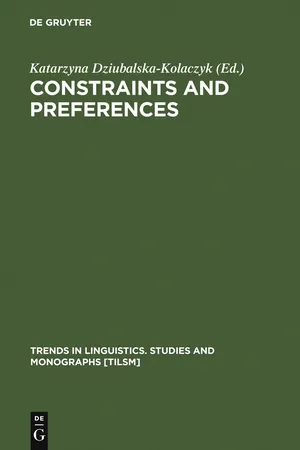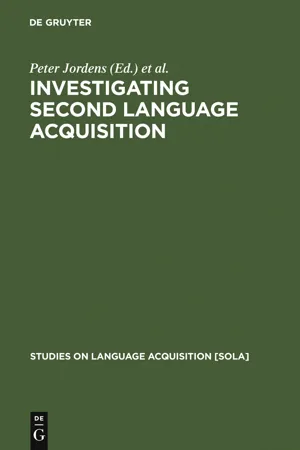Languages & Linguistics
Phonotactics
Phonotactics refers to the study of the permissible combinations of phonemes in a particular language. It examines the rules and patterns governing the arrangement of sounds within words, including syllable structure, consonant clusters, and permissible phoneme sequences. Phonotactics vary across languages and play a crucial role in shaping the phonological structure and pronunciation of words.
Written by Perlego with AI-assistance
Related key terms
1 of 5
8 Key excerpts on "Phonotactics"
- Prafull Dhondopant Kulkarni(Author)
- 2023(Publication Date)
- Society Publishing(Publisher)
INTRODUCTION TO Phonotactics 5 CONTENTS 5.1. Introduction .................................................................................... 129 5.2. Factors Affecting Pronunciation....................................................... 134 5.3. The Phonological Influence on Phonetic Change ............................ 141 5.4. Phonemic Incidence ....................................................................... 145 5.5. Targets of Phonetic Implementation ................................................ 149 5.6. Gestural Phasing and Interpolation ................................................. 150 5.7. Conclusion ..................................................................................... 153 References ............................................................................................. 154 CHAPTER Sounds in Dialects and Languages: An Introduction to Phonology 128 The concepts that govern how languages enable sound combinations and segment sequencing to create bigger units like syllables and words are referred to as Phonotactics. The study of Phonotactics deals with several obvious paradoxes and empirical concerns that necessitate crucial analysis and comparison of alternative conceptualizations as well as, quite often, an inquiry into the ‘interfaces’ between Phonotactics and other tiers of the linguistic organization, notably phonetics and morphology. The fact that Phonotactics is a part of a language’s phonological grammar while also being governed by a variety of non-categorical, probabilistic restrictions and preferences is, however, one issue.- eBook - PDF
The Sounds of Language
An Introduction to Phonetics and Phonology
- Elizabeth C. Zsiga(Author)
- 2012(Publication Date)
- Wiley-Blackwell(Publisher)
Phonology studies the social and mating habits of speech sounds. Paul Smolensky and Geraldine Legendre, The Harmonic Mind, 2006, p. 26 11 Phonotactics and Alternations Chapter outline 11.1 Phonotactic constraints 222 11.1.1 Actual words and possible words 222 11.1.2 Absolute and statistical generalizations 223 11.1.3 Borrowings 224 11.2 Analyzing alternations 225 11.3 Alternations: what to expect 232 11.3.1 Local assimilation 232 11.3.2 Long-distance assimilation 236 11.3.3 Coalescence 238 11.3.4 Dissimilation 238 11.3.5 Lenition and fortition 240 11.3.6 Epenthesis 241 11.3.7 Deletion 243 11.3.8 Lengthening and shortening 244 11.3.9 Metathesis 244 11.3.10 Morphological interactions 245 The Sounds of Language: An Introduction to Phonetics and Phonology, First Edition. Elizabeth C. Zsiga. © 2013 Elizabeth C. Zsiga. Published 2013 by Blackwell Publishing Ltd. 222 Phonotactics AND ALTERNATIONS In this chapter, we begin to investigate the question, “What does it mean to know a language?” focusing on the evidence from Phonotactics (possible sound sequences) and alternations (positionally-conditioned changes). As Smolensky and Legendre put it in the epigraph, Phonotactics might be considered the social habits of speech sounds: what sounds go together, and where can they be found? Alternations might be considered mating habits: when sounds get together they interact, things happen, and new sequences come into being. We begin in Section 11.1 with a discussion of phonotactic constraints: how does a speaker know whether a word is possible in her language or not? What form does the knowledge take? How are phonotactic constraints evidenced in borrowings? The bulk of the chapter, however, is devoted to alternations: what happens to sequences of sounds when phonotactic constraints are violated? Section 11.2 discusses general procedures for diagnosing and describing alter- nations in a phonological analysis. - eBook - PDF
Language Files
Materials for an Introduction to Language and Linguistics, 13th Edition
- Department of Linguistics(Author)
- 2022(Publication Date)
- Ohio State University Press(Publisher)
C H A P T E R 3 Phonology © 2015 by Julia Porter Papke 106 F I L E 3.0 What Is Phonology? Like phonetics, phonology has to do with the study of speech sounds (“phones”), but important differences exist between these related fields. As we saw in Chapter 2, phonet- ics is the study of speech sounds as physical entities: how they are produced in the vocal tract, what their articulatory and acoustic properties are, and how they are interpreted. Phonology, on the other hand, is the study of how sounds are organized within a language and how they interact with each other. Phonologists ask the following kinds of questions: What is the organization of sounds in a given language? Within a language, are there particular sounds whose distribution with regard to other sounds is predictable in some way? Which sounds are used in a language to distinguish between words? Contents 3.1 Phonotactic Constraints and Foreign Accents Introduces the idea that there are language-specific limitations on how sounds can be put together, and relates this to some of the reasons that non-native speakers of a language seem to have a foreign accent. 3.2 Phonemes and Allophones Introduces the two levels of phonological representation—phonemes and allophones—and describes the three basic ways sounds can be distributed in a language. 3.3 Phonological Rules Describes how phonological rules map between the two levels, introduces the idea of natural classes, and introduces several types of common phonological processes. 3.4 Implicational Laws Describes how certain phonological patterns recur in languages, in a particular ordered hierarchy, and introduces some explanatory principles for these patterns. 3.5 How to Solve Phonology Problems Outlines some basic techniques and strategies for solving phonological analysis problems. 3.6 Practice Provides exercises, discussion questions, activities, and further readings related to phonology. - Victoria Fromkin, Robert Rodman, Nina Hyams, , Victoria Fromkin, Robert Rodman, Nina Hyams(Authors)
- 2018(Publication Date)
- Cengage Learning EMEA(Publisher)
246 CHAPTER 6 Phonology: The Sound Patterns of Language Say these examples out loud, speaking naturally, and at the same time listen or feel the stress pattern. If English is not your native language, listen to a native speaker say them. These pairs show that stress may be predictable from the morphology and syntax. The phonology interacts with the other components of the grammar. The stress differences between the noun and verb pairs discussed in the previous section (subject as noun or verb) are also predictable from the syntactic word category. Intonation Depending on inflection, ah bon [in French] can express shock, disbelief, indifference, irri- tation, or joy. PETER MAYLE, Toujours Provence, 1991 In Chapter 5, we discussed pitch as a phonetic feature in reference to tone lan- guages and intonation languages and noted its role in determining meaning. We can now see that pitch is also a phonemic feature in tone languages such as Chinese, Thai, and Akan. We refer to these relative pitches as contrasting tones. In non-tone languages, such as English, pitch still plays an important role, but only in the form of the pitch contour or intonation of the phrase or sentence. In English, intonation may reflect syntactic or semantic differences. If we ask, “What is your middle name, David?” with falling pitch at the end it is a request to someone named David to reveal his middle name. With rising pitch at the end, it is a query as to whether the addressee’s middle name is David. A sentence that is ambiguous in writing may be unambiguous when spoken because of differences in the pitch contour. Written, the following sentence is unclear as to whether Tristram intended for Isolde to read and follow directions, or merely to follow him: Tristram left directions for Isolde to follow.- eBook - PDF
- Ralph W. Fasold, Jeff Connor-Linton(Authors)
- 2014(Publication Date)
- Cambridge University Press(Publisher)
articulation, the propagation of sound waves through the air, hearing and speech perception , computer measurement of fundamental frequency and formant structure. Phonologists study the more abstract organization of sound patterns: syllable structure, phonotactic constraints, alternations, the relationship between underlying and surface representations. We began this chapter by posing questions that phonologists and phoneticians ask, and have attempted to survey some of the preliminary answers that have been proposed. Phonologists and phoneticians have learned a lot about how speech sounds are made, how they are perceived, and how they are organized. But many questions remain. What new sounds and sound patterns remain to be discovered? How can we best (and most quickly) describe and preserve the sounds and sound patterns of the diverse languages that are dying out? As we gain more and more knowledge of how our mouths and ears work (from more and more sophisticated measuring devices), how can we incorporate this knowledge into our acoustic and articulatory models? As we gain more and more knowledge of how our brains work, how can we incorporate this knowledge into our phonological models? How do cognitive patterns and articulatory events in fl uence and constrain each other? What is the right set of distinctive features? Are phonological features and articulatory gestures one and the same? Is the relationship between underlying and surface representation rule-based or constraint-based? How can we account for language change and language variation? How can we better understand how children acquire the phonology and phonetics of their native language? How can we better understand the process of learning a non-native language, and help those who are struggling to do so? The studies that will answer these questions remain to be written. Exercises EXERCISES 1.1 Draw a mid-sagittal diagram of the vocal tract, using Figure 1.2 as a model. - eBook - PDF
Output-Driven Phonology
Theory and Learning
- Bruce Tesar(Author)
- 2013(Publication Date)
- Cambridge University Press(Publisher)
Section 5.6 provides discussion of restrictiveness biases in learning, including a review of selected prior work on restrictiveness biases in the learning of constraint rankings. Section 5.7 presents previously unpublished work on phonotactic contrast, work that will prove extremely useful for connecting the learning of constraint rankings with the learning of underlying forms. Section 5.8 discusses the fundamental limitations of purely phonotactic information for the learning of phonologies, setting the stage for Chapter 6, which will discuss the use of paradigmatic information in learning. 173 174 Learning Phonotactics 5.1 An overview of the learning problem Learnability is fundamentally about choosing from among a set of possibili- ties, based on data. The ease or difficulty of a particular learning problem is determined by the relations that hold between the different possibilities with respect to the kind of data that will be available to the learner. Linguistic theory is of central importance to language learning, because it determines the set of possibilities that the learner has to choose from. The data typically taken to be available to a phonological learner are the overt portions of (some of) the outputs of a grammar. In word-level phonology, an output of a grammar is a word (possible or actual) of the language, so a set of learning data would contain grammatical words of the language. Words are constructed out of morphemes. The phonological input for a word is formed by combining (in accordance with the morphology) the underlying forms for the morphemes of the word, and the output for a word can be divided into parts such that each part is the surface realization of a morpheme of the word. For present purposes, I will say simply that an output segment is part of the surface realization of a morpheme if it has an input correspondent which is part of the underlying form for that morpheme. - eBook - PDF
- Katarzyna Dziubalska-Kolaczyk(Author)
- 2011(Publication Date)
- De Gruyter Mouton(Publisher)
Phonotactic constraints are preferences Katarzyna Dziubalska-Kolaczyk 1. Introduction The main objective of this paper is to demonstrate that phonotactic constraints on consonant clusters should be understood as prefer-ences in the epistemological sense. For this purpose one needs: - A discussion of the notion of a preference against the notion of a constraint. - An explicit theory of preferences: Beats-and-Binding Phonology is embedded in the framework of Natural Linguistics, which is a preference theory of (cf. Dressier 1999a). - A model of Phonotactics: in this paper it is derived from the Beats-and-Binding Phonology (cf. Dziubalska-Kolaczyk 1995, 1996). 2. Preference theories 2.1. Epistemology The model of phonology referred to in this paper is embedded in the epistemological framework of Natural Linguistics (cf. Dressier 1996). This entails that it is explicitly constructed as a preference theory rather than a general descriptive theory, and it employs the epistemological approach of functional explanation. Particular lin-guistic choices are seen as results of goal-oriented linguistic behav-iour of language users and as such cannot be explained in the deduc-tive-nomological fashion, i.e. by the covering-law model , where an explanation is derived from general laws and background conditions (i.e. the explanans deductively entails the explanandum). On the cov- 70 Katarzyna Dziubalska-Kolaczyk ering-law model, a satisfactory explanation has the same logical structure as deriving a prediction on the basis of a scientific theory: If we have an adequate explanation of some occurrence, then, in principle, we could have predicted it before it actually took place (or before we knew that it had taken place) (Gasper 1993: 291). Since absolute predictions with reference to language behaviour (if not in general) are impossible (cf., e.g., dysfunctional behaviour or multi-and plurifiinctionality), causal explanations of the deductive-nomological type cannot be satisfactory. - eBook - PDF
- Peter Jordens, Josine Lalleman, Peter Jordens, Josine Lalleman(Authors)
- 2010(Publication Date)
- De Gruyter Mouton(Publisher)
2. Observational and descriptive preliminaries In studying L2 phonology we need to know that acquiring the sound system of a new language involves developing knowledge and skills of different types associated with the different levels of sound structure themselves. There is more to acquiring a new sound system than developing a new set of pronunciation habits, for instance. Knowledge of the underlying regularities of the new system, i.e. of its phonology in the narrower sense of the word, is equally part of the learning task, as is the development of a phonetic system, or representation, which forms the link between the more abstract, system properties of sounds and their status as purely articulatory-perceptual complexes. In practice, much of L2 phonology research has concerned itself with sounds as phonetic entities, thereby unfortunately obscuring the complex interplay between the development of system knowledge of the L2 and the development of practical sensori-motor pronunciation skills necessary for the realization of new sounds and new sound patterns. In summary, then, acquiring new phones, new syllable types, new stress patterns, new intonation or tone patterns involves synthesizing the phonological, phonetic and articulatory / perceptual properties of these sound elements according to the norms of the L2. Both the influence of the sound structure of a previously learnt language as well as universal preferences in sound structure may be present at all or any of these different levels. A practical example may serve to illustrate some of these potential complexities. Acquiring the L2 English [Θ] as in thigh [Gai] involves, in terms of a traditional phonemic analysis, establishing the phonological status of the phone as the phoneme /Θ/, distinguished from other phonemes such as /t/ as in tie, /s/ as in sigh and / / as in thy by the phonological features [dental] and [voiceless], for example (other features could also be employed for illustration purposes).
Index pages curate the most relevant extracts from our library of academic textbooks. They’ve been created using an in-house natural language model (NLM), each adding context and meaning to key research topics.







